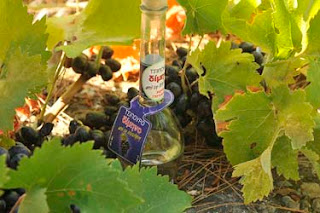(Tsipouro Dimino)
When you read about the history of alcoholic drinks like liquors, wine and beer, you may be amazed by the fact that many monasteries are part of their making. In monasteries in Belgium you still can taste beer, like the one that was invented by the Trappists in the seventeenth century.
It was the Greek god Dionysos that taught humans how to change grapes into wine. In the Middle Ages, wine making was mostly done in monasteries. God changed water into wine, so did the monks (well, they actually changed grapes into wine). Greek wines were famous worldwide and also produced by farmers, until the Turks invaded Greece in the fifteenth century. After that the farmers had to pay huge taxes and were unable keep their grape vines. However many monasteries were given privileges and so were able to keep on producing wine.
Of course the monks did not make alcohol to get pissed. Some saw it as a religious symbol – wine was considered to be the blood of Jesus Christ – and above all it was a healthy drink because it was made out of natural products. Some wines were even considered as medicine.
Monks used to be pretty busy people; they formed a closed community that had to produce their own food. So they worked the fields, brewed herb mixes to combat diseases and had all the time of the world to concoct new things; in earlier times monks looked for the secrets of life and were the scientists of the world. They also experimented with wine: an example being the liquor Chartreuse, made from 130 different herbs, which was created in a monastery close to Paris in the seventeenth century.
Much earlier, Greek monks had invented another drink through experimenting. Beginning in the first century they hacked monasteries out of the ground on the most eastern peninsula of Chalcidici (Macedonië), now renowned for its monastery empire Mount Athos. Wine from Athos was famous. In the fourteenth century a local monk used the ‘must’ that remained after the crushing of the grapes for wine to make another drink: tsipouro, called also tsikoudia (on Crete), raki (the Turkish name) or souma.
After ouzo, wine, retsina and beer, tsipouro is the most popular local alcoholic drink of Greece (whisky is more popular than tsipouro, but is not local). This strong beverage (around 40% alcohol) is best compared with Italian grappa. When the grapes are crushed, stems, skins and stones remain. This substance is put into kettles together with some wine and herbs and after several distillations it gives a clear liquid that may seem to look like ouzo but is quite different.
The secret of tsipouri is to be found in the herbs and everybody uses different ones. In some regions they add saffron, giving the liquid a bright yellow colour, similar to the yellow Chartreuse, although this is quite different. In other tsipouro’s they add aniseed and/or fennel, which creates anethole in the drink, meaning that when you add water it will turn white — just like ouzo, but a different drink. What they call raki in Turkey is often thought of as ouzo, but this is a tsipouro with aniseed and/or fennel.
Tsipouro is also called the poor brother of wine, because it is made with bi-products of wine making. When the recipe of tsipouro was presented to the world, it was mostly poor people and farmers producing and consuming it because the ‘must’, the herbs and the wood to keep the fire going under the distillation kettle did not cost any money. It was mostly made in an amateurish way in copper kettles and commerce in small communities was allowed. In 1883 the first taxes were imposed on alcoholic drinks. In 1896 the first licenses for tsipouri were issued. In 1989 tsipouro came under the European distillation laws and today it’s an official Greek product.
It is thanks to these laws that tsipouro has grown into a quality product. But, as you can imagine, there remained farmers who, in their barns, secretly stoked tsipouro according to their grandfathers’ recipe. And even now when visiting a Greek family, after dinner there might suddenly appear on the table a mysterious bottle with home made tsipouro.
It is said that tsipouro (provided that you drink moderately and eat some mezedes) never gives a hangover. I have to admit that I once drunk so much home-made tsipouro that I fell pretty ill. So for a long time I stayed away from this drink because even the smell made me sick. But now I have tasted another product of the island: the tsipouro Dimino, made in Mytilini — and I was pretty happy drinking it. Sometimes grappas and tsipouros have a flat taste, like you are drinking just alcohol, but Dimino has a full taste of autumnal fruits and herbs. Dimino is the only tsipouro officially produced on Lesvos.
Since the crisis in Greece, prices have risen speedily. In the eight years since I came here, prices for alcoholic drinks have nearly doubled or tripled. The monasteries no longer produce wine, the church now is brewing dinners for the fast growing population group that cannot afford Greek life anymore.
Luckily, here on the island, not many people need to knock on the monasteries’ doors for food. Most of them have their own garden — hence their own food. Many people also make their own wines. And even though Dimino is a very good quality tsipouro, I won’t be surprised, if, during the coming grape harvest, the illegal distilleries will be taken out of hiding again.











